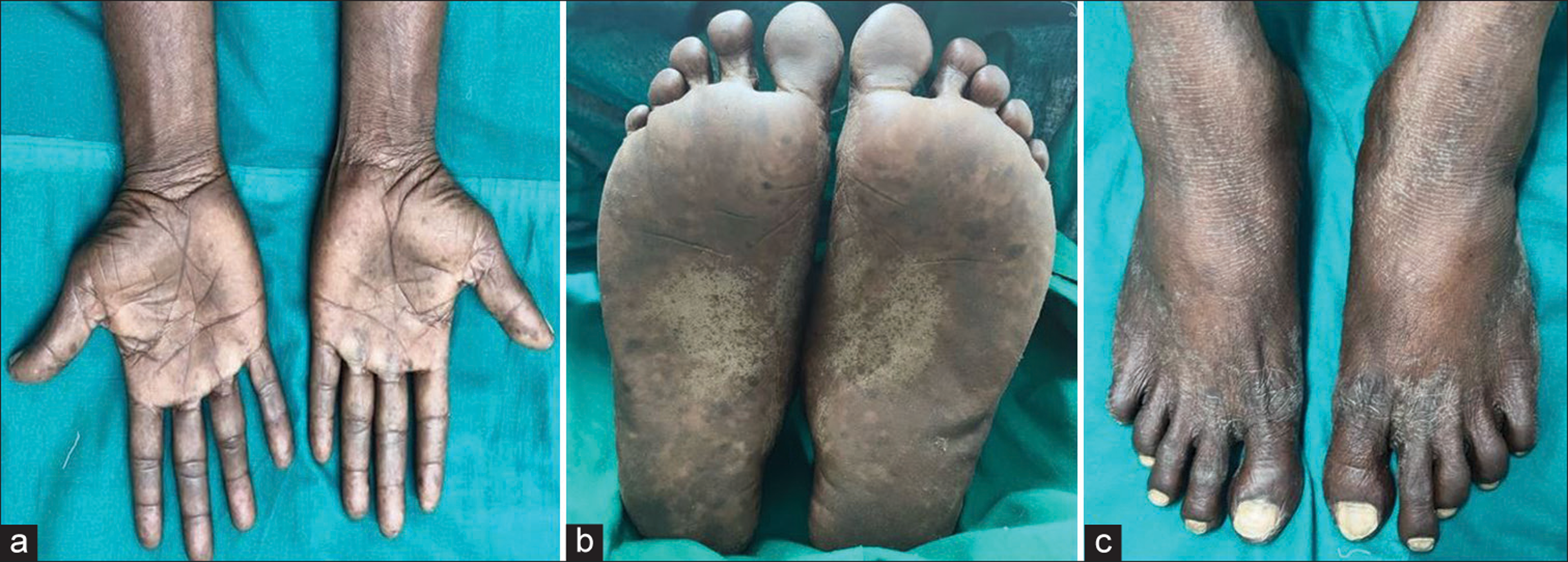Translate this page into:
Hydroxyurea-induced hand-foot syndrome

*Corresponding author: Logamoorthy Ramamoorthy, Department of Dermatology, JIPMER, Puducherry, India. logamoorthy.r@gmail.com
-
Received: ,
Accepted: ,
How to cite this article: Ramamoorthy L, Monisha GA. Hydroxyurea-induced hand-foot syndrome. CosmoDerma 2023;3:153.
A 40-year-old male known case of essential thrombocytosis presented with pigmentation and burning sensation in the palms and soles for the past 2 months. The patient has been on treatment with hydroxyurea 500 mg twice daily for the past 3 months. On cutaneous examination diffuse erythema and hyperpigmentation seen over the bilateral palms and soles [Figure 1a-c]. Based on history and clinical examination, hydroxyurea-induced hand-foot syndrome was diagnosed. The patient was treated with topical betamethasone cream and advised regular follow-up.

- (a-c) Diffuse erythema over the palms and soles with accentuation in areas of weight-bearing and additional areas of hyperkeratosis and focal desquamation in the soles with extension to the dorsum of toes.
Palmoplantar erythrodysesthesia, also called Burgdorf syndrome, acral erythema, toxic erythema of chemotherapy, or hand-foot syndrome, is commonly seen with chemotherapeutic agents. Hydroxyurea-associated acral erythema is associated with long-term hydroxyurea use, usually at doses equal to or greater than 1 g daily. It can start from weeks to years after initiation of hydroxyurea. In a large retrospective review of patients with myeloproliferative neoplasms treated with hydroxyurea, <10% of patients treated with hydroxyurea developed any mucocutaneous toxicities, out of which more than 80% of patients had cutaneous ulceration and oral mucosal aphthae. Hand and foot syndrome has been previously reported in association with hydroxyurea with chronic myeloid leukemia and sickle cell disease.[1] We present this case of hand-foot syndrome as a rarely encountered cutaneous adverse effect associated with hydroxyurea in a case of essential thrombocytosis.
Declaration of patient consent
The authors certify that they have obtained all appropriate patient consent.
Conflicts of interest
There are no conflicts of interest.
Use of artificial intelligence (AI)-assisted technology for manuscript preparation
The authors confirm that there was no use of artificial intelligence (AI)-assisted technology for assisting in the writing or editing of the manuscript and no images were manipulated using AI.
Financial support and sponsorship
Nil.
References
- Hydroxyurea-associated acral erythema in a patient with polycythemia vera. Am J Hematol. 2014;89:931-2.
- [CrossRef] [PubMed] [Google Scholar]





